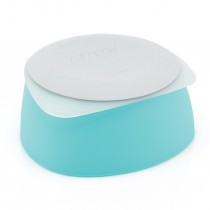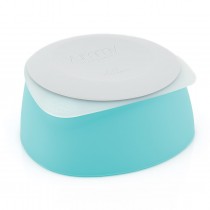We don't sell dog food but we know eating safely is very important.. But part of keeping your dog safe is feeding him or her the food that will provide them with a long, healthful life.
To that end, here is an overview of dog food, along with a few recommendations. For years dog owners fed their loving companions whatever was at eye level in the local grocery store's pet aisle. Not anymore. More and more dog lovers are now feeding their pets natural or organic food, many starting when they first get a new pet. Is this necessary? What's the difference between the "regular" old-fashioned pet food that you can buy at a grocery or big box retail store and natural dog food? It is worth the price? And what does "grain free" or "raw" mean for your pet? Let's find out. First, a little background.
The Big Brands
For years, you've heard about Purina, Pedigree, Iams, Hills Science and other brands. Because pets are a very big business, it's not surprising that these well-known brands are now owned by much larger companies. Hills (Colgate), Purina (Nestle), Pedigree (Mars), and Iams and Eukanuba are owned by Procter and Gamble. Dog food is quite profitable, and these massive corporations have taken note and have acquired these companies.
The Natural Push
Natural pet food is where new pet food companies are rising up. Natural brands have always been popular in smaller mom and pop pet supply shops but these brands are now showing up in big box pet stores (Petco, Petsmart) as well as grocery stores and big box retailers. And by the way, all of the above brands offer natural food lines. Just like natural food for humans, natural pet food has a higher profit margin than traditional processed food.
So is it worth it? Here are five reasons why it is:
1. In some cases, serving sizes are smaller, so the cost is similar. With natural pet food, serving sizes are sometimes smaller. So, the ultimate cost is about the same. This isn't always the case. But as for humans, you could argue that feeding your dog natural food keeps them healthier than processed food, so you will spend less money at the vet and more on food.
2. It's all about the first five ingredients. Dog food in the grocery store typically has these five ingredients listed first: Ground Whole Corn, Chicken By-Product Meal, Corn Gluten Meal, Animal Fat (Preserved With Mixed Tocopherols), and Whole Wheat Flour. You'll notice the first ingredient is not a protein, but a carb (corn). Corn is extremely inexpensive in the United States because of government corn subsidies which has led to corn most famously replacing sugar as the sweetener of American sodas, and showing up in all kinds of other strange places (cereal, cattle feed). In the pet food industry corn is often called a "filler" because it is there to save money and to fill the kibble up with something. It has very little nutritional value for dogs, but it is in the first five ingredients twice in many of the big box brand foods. The main protein source is the second ingredient which starts great with Chicken, but ends with the strange phrase "By-Product Meal." This means it's the left-over chicken parts and pieces after all of the desirable cuts are shipped off from the slaughterhouse. So it's essentially everything people won't buy for themselves, ground up and added into the kibble to act as the dog's main protein source. Animal fat is actually a very normal source of fat in dog food, often a specific animal is referenced (i.e. chicken fat), but this is not particularly problematic. Whole wheat flour however is another "filler" ingredient to round out the top five. There is very little nutrition to be found in wheat for dogs, and it often is the source of allergic reactions for dogs with food allergies. Compare this to the first five ingredients in a natural dog food. Nature's Variety's Prairie Beef Meal and Barley Medley has these first five ingredients: Beef meal, Barley, Brown Rice, Oatmeal, and Chicken Fat (preserved with mixed tocopherols and citric acid). Beef Meal is quite different from Beef Bi-Product Meal as it is not the leftovers from the slaughterhouse, it is actual cuts of beef that have been ground up and dehydrated which is why for this food they call it a "Meal" instead of simply Beef. This is the main protein source here and is the first ingredient. Barley, Brown Rice, and Oatmeal are all grains and some dogs do require grain-free diets due to allergies, but they are nutrient rich carbohydrate sources for dogs, and can be found in many natural food varieties. And lastly Chicken Fat is relatively self-explanatory and acts as the main fat source for the food, but mixed tocopherols sounds sort of odd. These are actually different forms of vitamin E mixed together, and are commonly used in natural and organic foods to preserve fats.
3. Consider special varieties. Many pet owners go beyond feeding their animals a natural diet and this is where grain-free, raw, and human grade foods have begun to take their share of the natural pet food market. Grain-free simply means that particular food has no grain. Often foods that are grain free have potatoes or sweet potatoes as their main carbohydrate sources. Many dogs need grain-free foods to avoid food allergies that small pure-bred dogs are particularly affected by. These varieties also often have a much higher protein content than other foods, and because many dogs don't need extra protein, it's important to watch out for this. Blue Buffalo for instance has two grain-free lines of food, Blue Wilderness and Blue Freedom. Wilderness is a great food, but has a minimum protein content of about 34% while most dog foods sit in the mid-twenties. Blue Freedom is grain-free, but maintains the more normal mid-twenties protein percentage which is perfectly appropriate for most dogs. Raw food can mean a few things. It can mean a dog owner physically making full meals for their pooch from scratch using dog-safe ingredients from the grocery store, or as pet food retailers know it, it means either freeze dried raw formulas or frozen raw formulas. Nature's Variety produces frozen raw food while brands like Dr. Harvey's produce a few freeze dried formulas. These food varieties are noticeably more expensive than even natural food dry and wet formulas, but many dedicated pet owners prefer to truly see their animal's food, and to give them something that is at least close to what they might eat themselves. Some dogs do have such bad food allergies that their owners actually have to spring for raw just to get them to eat something without having a reaction.
4. Consider the protein source. The overall protein source is a point of contention for many pet owners. Popular human proteins like chicken and beef are occasionally problematic for dogs with wheat allergies because some grain-free foods still contain cattle or chickens that were fed grain and some dogs are so sensitive to that grain that they can have reactions from the protein within. This is why many dog owners try for less popular proteins like duck, venison, or rabbit to meet their dogs needs.
5. What works for you? What you feed your dog is a matter of personal preference. However, we recommend that you strongly consider natural dog food for your pet. Beyond that, raw or grain-free foods are good options, particularly if your pet has food allergies.















I am happy to see your post. We should know that which type and which size of food our dog is like. These reasons are much appreciated and should keep in mind when begin to start feeding our pets.
Leave a comment